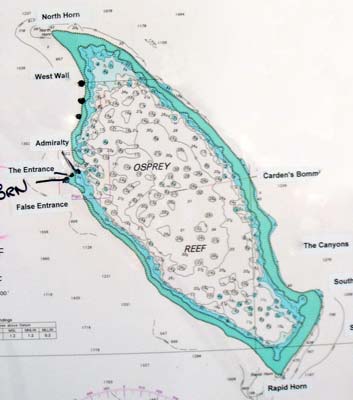 |
A chart of Osprey Reef
North Horn is at the very top |
Osprey Reef is located approximately 130 kilometres off the Great Barrier Reef in the Coral Sea. It is about 200 kilometres from the mainland. The reef itself basically runs from north-west to south-east and is about 30 kilometres long and 10 kilometres wide. There is a single decent entrance to the only lagoon (which is about 25 to 27 metres deep for the most part) that is located about two thirds of the way from the southern point to the northern point. Boats steam to Osprey from the GBR overnight, with most boats taking about 10 to 12 hours depending on the conditions and where you are leaving the main reef.
This is the very northern point of Osprey Reef. The GPS Reading is S13° 48' 05.2" E146° 32' 45.7" using WGS84 as datum. It is approximately 320 kilometres from Port Douglas. The location obviously gets its name from the shape of the reef which from the air looks like a horn on a unicornfish or similar. There are two sections of reef to follow. One is the western side and the other is the northern side.
Where the two main sections of the reef join, they do not meet in a < shape but more in a blunt [ shape. That is, there is a section of reef between the reef coming from the south (the one facing west) and the reef coming from the east (the north and east facing one) are joined by a short section that runs for perhaps 50 metres. Deeper, the reef goes to a point. The depth there is about 35 to 40 metres.
There is a mooring on a bommie in about 12 metres of water at the above GPS reading.
Undersea Explorer run a shark dive at this location. Just to the north of the mooring is a largish bommie. On the top of this is a bit of chain and some floats. This is a shark listening station, although the device is not always there.
As you descend you will see that there are a lot of sharks milling around. These obviously know that something is about to occur. The crew of the Undersea Explorer will set the divers up against the wall around two sides of the amphitheatre that sort of surrounds the bommie. Once everyone is in place, the crew bring down a couple of joined milk crates which have the remains of fish used for making a previous dinner. This is placed on top of the bommie and soon all hell breaks loose.
 |  |
| A grey reef shark at North Horn | A white-tipped reef goes behind the dives taking photos |
Small fish attack the crates followed by sharks. Even a potato cod will come in and try to extract some fish remains from the crates. Even though the remains are totally within the confines of the crate, some of the fish and sharks are able to grab bits of the fish remains and pull them out. The lucky sharks take the food and quickly swim away to lessen the chance of any other shark taking the food off them.
As well as all these fish, there are two very large yellow-edged moray eels that live on top of the bommie. These try to get the fish remains out of the crates and look for any bits dropped by the sharks. The sharks come in and around the bommie, enabling you to get some close up photos. After it has calmed down a little, the crew will take divers in pairs up close for an even more exciting thrill. A minute or two and it is other divers turn.
 |  |
| Another white-tipped reef shark at North Horn | The largest of the yellow edged moray eels
that live on the bommie at North Horn |
As well as white-tipped reef sharks, you may see silver tips and grey reef sharks. These last sharks are much larger and more fierce looking. After the crates are taken back to the boat, go up to the top of the bommie and you will be able get some great photos of the moray eels (which are very friendly) as well as the sharks which are still circling. The largest moray has a deformed jaw and the top half sits to the right of the bottom jaw.
After this, do a bit of exploration as per the North Horn dive.
A very good shark dive, the best I have done in Australia, but not as good as the old shark feed at Bokissa Island in Vanuatu (not run now) or the shark dive in Chuuk Lagoon.
I have two other dive descriptions for this location, see North Horn and North Horn Drift Dive. Visibility here is nearly always at least 40 metres.
Click here to return to the Osprey Reef article page.
| 
 v6.00.307 © 2003-2005
v6.00.307 © 2003-2005